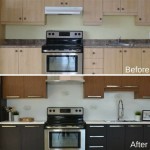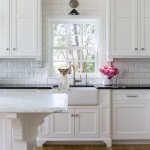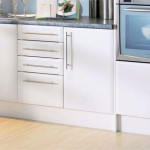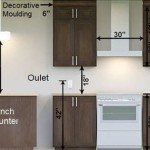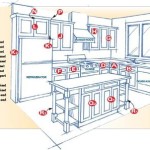How To Adjust Brackets On Kitchen Cabinets
Kitchen cabinets, integral to both the functionality and aesthetics of a kitchen, rely heavily on proper installation and alignment. Even minor misalignments can lead to issues with door closure, uneven appearances, and potential structural problems over time. Addressing these issues often involves adjusting the brackets that secure the cabinets to the wall. This article provides a comprehensive guide to adjusting these brackets, enabling homeowners to achieve a polished and functional kitchen layout.
Before commencing any adjustments, it is crucial to identify the type of brackets used. Common types include European-style concealed hinges, surface-mounted hinges with visible plates, and clip-on brackets. Each type requires a slightly different approach, and understanding the specific bracket style is essential for effective adjustment.
Gathering the necessary tools is the next preparatory step. Typically, this includes a screwdriver, preferably with interchangeable bits to accommodate different screw heads. A drill with a screwdriver bit attachment can also be beneficial for quicker adjustments. A level, preferably a torpedo level for tight spaces, is essential for ensuring accurate alignment. Shims, small wooden wedges, are frequently required for minor adjustments to cabinet positioning.
Safety precautions should always be prioritized. Before beginning any work, it's advisable to turn off the power supply to the kitchen to avoid electrical hazards. Wearing safety glasses is recommended to protect the eyes from debris or falling screws. Gloves can also be worn to improve grip and protect hands.
Starting with the upper cabinets, visually inspect for any signs of misalignment. Doors that don't close properly, gaps between cabinets, or cabinets that appear tilted are all indicators of potential bracket adjustments. Open the cabinet door and locate the mounting screws that secure the bracket to the wall. These are typically located inside the cabinet, near the top and bottom corners.
Using the appropriate screwdriver or drill attachment, carefully loosen, but do not completely remove, the mounting screws. Begin with the screws closest to the area of misalignment. For example, if a cabinet is leaning forward, loosening the top screws will allow for adjustments. If the cabinet is too high or low, all screws may need slight loosening.
Once the screws are loosened, the cabinet can be gently shifted into the desired position. Utilizing the level, ensure the cabinet is plumb (perfectly vertical) and level (perfectly horizontal). Shims can be inserted behind the brackets to fill any gaps and ensure a snug fit against the wall. These shims can then be trimmed flush with a utility knife once the cabinet is properly aligned.
After achieving the correct alignment, carefully retighten the mounting screws. It is crucial to tighten screws gradually and evenly to prevent the cabinet from shifting during the process. Double-check the alignment with the level after tightening to confirm the cabinet remains in the desired position.
Lower cabinets follow a similar adjustment process. However, access to the mounting brackets may be different. Some lower cabinets have adjustable legs that need to be adjusted first. These legs typically have a screw mechanism that can be turned to raise or lower the cabinet. Once the legs are adjusted, the mounting brackets can be accessed and adjusted following the same procedure as the upper cabinets.
For cabinets with European-style concealed hinges, the adjustments are typically made at the hinge itself rather than the mounting bracket. These hinges have multiple adjustment screws that control the vertical, horizontal, and depth positioning of the door. Consult the manufacturer’s instructions for the specific hinge model to understand the function of each adjustment screw.
Dealing with clip-on brackets generally involves detaching the cabinet from the bracket entirely. This is done by releasing the clips that secure the cabinet to the bracket. Once detached, the bracket's position can be adjusted on the wall, and the cabinet reattached. Ensure proper alignment before reattaching the cabinet.
Throughout the adjustment process, regularly step back and observe the overall alignment of the cabinets. Ensuring a cohesive and visually appealing result requires attention to both individual cabinet adjustments and the overall kitchen layout. Making minor adjustments to neighboring cabinets may be necessary to achieve a seamless alignment across the entire kitchen.
Regular maintenance and inspection of cabinet alignment can prevent more significant issues from developing. Periodically checking for loose screws and addressing minor misalignments promptly can save time and effort in the long run.
While this guide provides a general overview, consulting a professional contractor is always advisable for complex adjustments or if there is any uncertainty regarding the process. Professional expertise can ensure the job is done correctly and prevent potential damage to the cabinets or surrounding structures.

Wall Unit Fitting Adjustments Diy Kitchens Advice

Wall Unit Fitting Adjustments Diy Kitchens Advice

Wall Unit Fitting Adjustments Diy Kitchens Advice

How To Install Kitchen Cabinets The Wall And Floor With Ease

How To Install Kitchen Cabinets The Wall And Floor With Ease

Wall Unit Fitting Adjustments Diy Kitchens Advice

How To Adjust A Kitchen Corner Cabinet

X2 Kitchen Wall Cabinet Hanger Mounting Plastic 29000740

Spider Concealed Cabinet Hanger Unhanded Dowel S Fixing

How To Attach A Drawer Front And Adjust Diy Kitchens Advice
Related Posts

